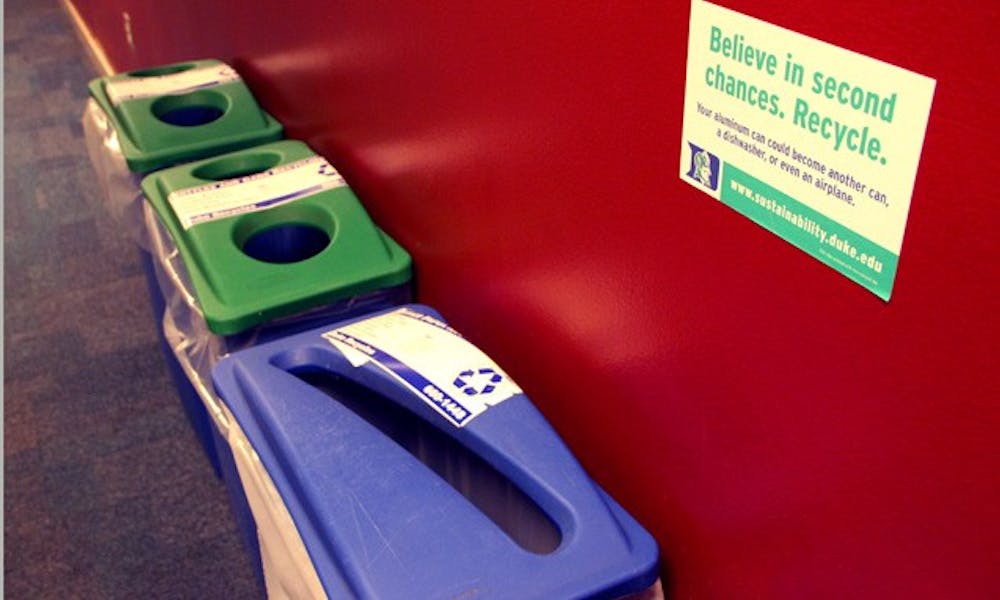Duke has been working toward becoming more sustainable, but the University has some steps to go before attaining its long-term goal.
Duke signed a pledge in 2007 to become carbon neutral by 2024 and has undertaken several initiatives to achieve this in the past several years, said Sarah Burdick, director of administration and special projects in Facilities Management. The University has also taken on initiatives to integrate sustainability into its overall curriculum.
“So far, becoming coal free has been Duke’s biggest accomplishment,” Burdick said. “We eliminated coal use on campus in May 2011, and we have achieved a 5 percent reduction in electricity usage in 2010 compared to a 2007 baseline.”
Based on a 2007 baseline for carbon emissions, Duke has achieved about a 9 percent reduction as of 2010. This reduction can be attributed to a reduction in coal use and energy conservation measures, Burdick said. In 2010, 46 percent of emissions came from electricity use, 29 percent for stationary fuel, 14 percent for air travel and 9 percent for commuting. The conversion of the East Campus Steam Plant from a coal-burning to natural gas plant cut coal consumption by 70 percent.
“This year, we hope to see a 4 to 5 percent reduction in overall emissions through transportation changes and carbon offsets,” Duke Sustainability Outreach Coordinator Casey Roe said. “Duke has taken a holistic approach in reducing carbon emissions, and so far, it has paid off.”
The University reached a peak greenhouse gas emissions level of 448,754 metric tons in 2008, according to the Duke Sustainability website. Duke first measured its emissions in 1990, when the University emitted close to 240,000 metric tons of carbon dioxide. In 2010, total emissions were at 406,109 metric tons.
To achieve carbon neutrality, Roe said the University will take both large and small steps.
“We have installed solar panels on the Bryan Center, and we are taking efforts in transportation to reduce the number of cars coming to campus every day,” she said.
Two new hybrid buses were added to Duke’s transportation fleet in November. Other major projects to offset carbon emissions are also underway.
“We are on the right path with regards to our projects,” Roe said. “We have seen an 8 to 10 percent reduction in emissions in the last couple of inventories, and we have a lot of projects lined up and ready to go.”
Duke will also be cooperating with Siemens AG, a global engineering and electronics company, to evaluate older buildings to reduce energy consumption, Burdick said. The partnership is expected to reduce overall carbon emissions by less than 2 percent, which she noted is still an important reduction.
Sustainability at Duke goes much further than just the accumulation of large projects, added Charlotte Clark, lecturer in sustainability education and faculty director of sustainability.
“Part of the [American College and University Presidents’ Climate Commitment] that President [Richard] Brodhead signed includes a segment that says Duke will take action to make carbon neutrality a part of the curriculum with all students,” Clark said.
Clark noted the importance of increasing undergraduate and graduate student involvement to emphasize sustainability as a University-wide commitment
“We are finding ways to formulate syllabi to include more sustainability objectives,” she said. “We are not just thinking about protecting human health, we are thinking about a sustainable economic system.”
Several Duke professors have incorporated sustainability into classroom exercise.
Melissa Simmermeyer, a lecturer in the Spanish language program, has her students translate passages relating to sustainability.
Linda Franzoni, associate dean of student affairs and professor at the Pratt School of Engineering, has similarly incorporated the study of the life cycle of materials into her class.
“These are just small examples of faculty delivering courses in ways that increase sustainability literacy,” Clark said.
To improve performance in sustainable literacy, Duke has also founded the Trillium Fellows Project—a faculty workshop in which professors can learn how to better translate sustainability goals into a variety of courses and curriculums.
“While [Duke faculty and staff] are very good at educating students about sustainability, our end goal is to change behavior,” Clark said. “So far, we have not been able to develop an evaluation mechanism to measure these changes. However, we have significant reasons to be hopeful that the progress made in achieving both sustainable literacy and carbon neutrality will increase significantly over the coming years.”
Get The Chronicle straight to your inbox
Signup for our weekly newsletter. Cancel at any time.

